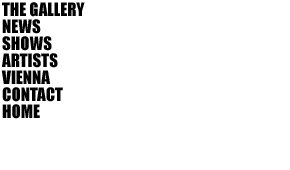
SALON NOUVEAU Exhibtion: 26/01/2007 - 21/03/2007 Press
Release "The
demands made on the spectator by the hanging pass our understanding…
Are you to hire stilts to rise to the ceiling or to get on your hands
and knees to sniff anything below the dado? One can see the 19th century
audience strolling, peering up, sticking their faces in pictures and
falling into interrogative groups a proper distance away, pointing
with a cane, perambulating again, clocking off the exhibition picture
by picture… What perceptual law could justify such a barbarity?" Brian O'Doherty,
“Inside the White Cube – The Ideology of the Gallery Space,”
1976 Hundreds, often
thousands, of paintings, drawings and prints were selected by appointed
juries. Their placement within the patchwork installation was decided
by committee, a process as political as it was aesthetic. A series
of rules dictated the organization of each wall, based on an adherence
to the traditional hierarchy of painting genres (history, portrait,
still life and landscape) and a commitment to lateral symmetry. Visitors
flocked to see the exhibitions in vast numbers, from Kings and Queens
and their aristocrats to the lowest ranks of the urban middle-class.
The salons became an important meeting place for artists, patrons
and collectors, while published descriptions of their annual offerings
marked the beginning of the modern occupation of the art critic. During the last
century however, such displays became increasingly rare. Indeed, so
swift and complete has been the system's fall from grace that contemporary
commentators find themselves questioning how it could ever have existed
in the first place. Today's audience has become accustomed to a radically
different way of looking at art in which works are more sparsely distributed,
often within a pure, white space - “an ideal space,” O'Doherty
writes, “that more than any single picture, may be the archetypal
image of 20th century art". Salon
Nouveau proposes a return, albeit temporary, to a time consigned
to history. It rudely dispenses with the pure aesthetic of linear
narrative, restoring to its place the system of elaborate viewing
patterns between works of contrasting size and subject matter hung
cheek-by-jowl on the full face of the gallery's walls. It empowers
the viewer, inviting us to move in, step back and choose between a
multiplicity of possible viewpoints in order to to make visual sense
of the presentation. And it should, by modernist standards, be a total
disaster. But this salon
is no servant to nostalgia, and nor is it an historicist manifesto
intended to trumpet the superiority of classical techniques for displaying
art. Rather, it is a salon of the new - a generation often famously
excluded from such events - and a challenge to practices both past
and present. More than 100 works by over 50 different artists are
presented. Using the cover provided by the age-old mediums of paint
and pencil, they ambush the traditional genres of art-making and heed
Baudelaire's call to adopt the complexity of contemporary life as
their subject. Images of royalty
are thus replaced by those of celebrity, portraits of war heroes exchanged
for depictions of terrorists and spies. Landscapes threaten, still
lifes deceive, and religion, once rampant up and down the walls, is
all but absent. Respecting the
historical rules of installation, Salon Nouveau invites
contemporary viewers to muse upon the history of display and the sheer
theatre of exhibiting art, to question the merits of the prevailing
system today, and to free oneself – just briefly – from the burden
of modern good taste. List of artists:
Rafal Bujnowski, Lordan Bunch, Ernesto Caivano, Marcin Cienski, Ross
Chisholm, Jose Damasceno, Jay Davis, Tami Demaree, Angela Dufresne,
Mark Fairnington, Samantha Fields, Cyprien Gaillard, Tim Gardner,
Meghan Gerety, Margarita Gluzberg, Angelina Gualdoni, Kay Harwood,
Nadia Hebson, Samuel Herbert, Colter Jacobsen, Titus Kaphar, Hannu
Karjalainen, Edward Kay, Hendrik Krawen, Cary Kwok, Michael Landy,
Rezi van Lankveld, Robert Lazzarini, Sea-Hyun Lee, Patte Loper, Billy
Malone, Jin Meyerson, Richard Moon, Katy Moran, Dwayne Moser, John
Murphy, Elizabeth Neel, Pat O’Connor, Djordje Ozbolt, Seb Patane,
Drago Persic, Claire Pestaille, Ged Quinn, Alessandro Raho, Fabian
Reimann, Andrew Sendor, Christoph Steinmeyer, Tim Stoner, Catherine
Story, Miha Strukelj, Duncan Swann, Dolly Thompsett, Barry Thompson,
Tommy White, Vicky Wright. |
|


